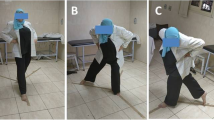Abstract
Background
There are numerous reports and evidences to suggest that exercise therapy is effective for knee osteoarthritis (knee OA). However, there is a lack of sufficient research concerning the factors influencing its application and effectiveness. The purposes of this study were to evaluate effects of the mode of treatment delivery on the improvement of symptoms in knee OA, and to analyze potential risk factors affecting improvement after exercise therapies.
Methods
The 209 women applicants diagnosed with knee OA were randomly allocated into either a group performing group exercise in a class or a group performing home exercise. The 90 min exercise program was performed under the guidance of physiotherapists as a group exercise therapy. The Western Ontario and McMaster Universities Osteoarthritis Index (WOMAC) of the subjects of both groups before and after intervention was compared to examine the effect of exercise therapy. In addition, body mass index, knee range of motion (ROM), the femorotibial angle from radiographs, OA severity from Kellgren–Lawrence grade, and meniscus abnormality and subchondral bone marrow lesions from MRI findings were statistically analyzed as factors that may affect exercise therapy.
Results
A significantly greater improvement in WOMAC was observed in the subjects of group exercise (81 subjects) as compared with the subjects of home exercise (122 subjects). There was a significantly high proportion of subjects with knee flexion contracture among the subjects participating in group exercise that showed only minor symptom improvement (p < 0.05). In addition, exercise therapy proved to be highly effective for subjects with limited quadriceps muscle strength (p < 0.05).
Conclusions
When prescribing exercise therapy for knee OA, evaluation of a subject’s ROM and muscle strength is important in deciding whether to commence exercise therapy and what type of exercise therapy to apply; it is also important in predicting the effect of exercise therapy.


Similar content being viewed by others
References
Lubar D, White PH, Callahan LF, Chang RW, Helmick CG, Lappin DR, Melnick A, Moskowitz RW, Odom E, Sacks J, Toal SB, Waterman MB. A national public health agenda for osteoarthritis 2010. Sem Arth Rheum. 2010;39:323–6.
Richmond J, Hunter D, Irrgang J, Jones MH, Snyder-Mackler L, Van Durme D, Rubin C, Matzkin EG, Marx RG, Levy BA, Watters WC 3rd, Goldberg MJ, Keith M, Haralson RH 3rd, Turkelson CM, Wies JL, Anderson S, Boyer K, Sluka P, St Andre J, McGowan R, et al. American academy of orthopaedic surgeons clinical practice guideline on the treatment of osteoarthritis (OA) of the knee. J B Jt Surg Am. 2010;92:990–3.
Jordan KM, Arden NK, Doherty M, Bannwarth B, Bijlsma JW, Dieppe P, Gunther K, Hauselmann H, Herrero-Beaumont G, Kaklamanis P, Lohmander S, Leeb B, Lequesne M, Mazieres B, Martin-Mola E, Pavelka K, Pendleton A, Punzi L, Serni U, Swoboda B, Verbruggen G, Zimmerman-Gorska I, Dougados M. EULAR recommendations 2003: an evidence based approach to the management of knee osteoarthritis: report of a task force of the standing committee for international clinical studies including therapeutic trials (ESCISIT). Ann Rheum Dis. 2003;62:1145–55.
Zhang W, Moskowitz RW, Nuki G, Abramson S, Altman RD, Arden N, Bierma-Zeinstra S, Brandt KD, Croft P, Doherty M, Dougados M, Hochberg M, Hunter DJ, Kwoh K, Lohmander LS, Tugwell P. OARSI recommendations for the management of hip and knee osteoarthritis, part I: critical appraisal of existing treatment guidelines and systematic review of current research evidence. Osteoarth Cartil. 2007;15:981–1000.
The Japanese Orthopaedic Association Japanese Knee Society. Assessment criteria for knee diseases and treatments. Tokyo: Kanehara; 1994.
Bellamy N, Buchanan WW, Goldsmith CH, Campbell J, Stitt LW. Validation study of WOMAC: a health status instrument for measuring clinically important patient relevant outcomes to antirheumatic drug therapy in patients with osteoarthritis of the hip or knee. J Rheumatol. 1988;15:1833–40.
Kellgren JH, Lawrence JS. Radiological assessment of osteoarthrosis. Ann Rheum Dis. 1957;16:494–502.
Stoller DW, Martin C, Crues JV 3rd, Kaplan L, Mink JH. Meniscal tears-pathologic correlation with MRI imaging. Radiology. 1987;163:731–5.
Nakamura E, Torisu T, Tomari K, Nakamura T, Asao T, Takagi K, Masumi S. Clinical significance of subchondral cortical signal intensities in osteoarthritis of knee joints. Nichiji Ishi (JJMRM). 1996;16:243–51 (in Japanese).
Roddy E, Zhang W, Doherty M, Arden NK, Barlow J, Birrell F, Carr A, Chakravarty K, Dickson J, Hay E, hosie G, Hurley, Jordan KM, McCarthy C, McMurdo M, Mockett S, O’Reilly S, Peat G, Pendleton A, Richards S, et al. Evidence-based recommendations for the role of exercise in the management of osteoarthritis of the hip or knee––the MOVE consensus. Rheumatology. 2005;44:67–73.
Fransen M, McConnell S. Land-based exercise for osteoarthritis of the knee: a metaanalysis of randomized controlled trials. J Rheumatol. 2009;36:1109–17.
Irie K, Watanabe K, Tomatsu T. Effects and influencing factors of quadriceps setting program on patients with knee osteoarthritis. Undou Butsuri Ryohou (J Physical Medicine). 2002;13:249–54 (in Japanese).
Torii S. The characteristics of the improved cases of mild or moderate knee osteoarthritis by intervention to increase muscle strength about the knee and hip joint. Heal Sci. 2003;19:122–6 (in Japanese).
Fransen M, Crosbie J, Edmonds J. Physical therapy is effective for patients with osteoarthritis of the knee: a randomized controlled clinical trial. J Rheumatol. 2001;28:156–64.
Lim B-W, Hinman RS, Wrigley TV, Sharma L, Bennell KL. Does knee malalignment mediate the effects of quadriceps strengthening on knee adduction moment, pain, and function on medial knee osteoarthritis? A randomized controlled trial. Arthritis Rheum. 2008;59:943–51.
Link TM, Steinbach LS, Ghosh S, Ries M, Lu Y, Lane N, Majumdar S. Osteoarthritis: MR imaging findings in different stages of disease and correlation with clinical findings. Radiology. 2003;226:373–81.
Felson DT, McLaughlin S, Goggins J, LaValley MP, Gale ME, Totterman S, Li W, Hill C, Gale D. Bone marrow edema and its relation to progression of knee osteoarthritis. Ann Intern Med. 2003;139:330–6.
Acknowledgments
We sincerely thank Drs.Tsuyoshi Minowa, Kenji Tateda, and Ima Kosukegawa for their help.
Conflict of interest
The authors declare that they have no conflict of interest.
Author information
Authors and Affiliations
Corresponding author
About this article
Cite this article
Kudo, M., Watanabe, K., Otsubo, H. et al. Analysis of effectiveness of therapeutic exercise for knee osteoarthritis and possible factors affecting outcome. J Orthop Sci 18, 932–939 (2013). https://doi.org/10.1007/s00776-013-0443-9
Received:
Accepted:
Published:
Issue Date:
DOI: https://doi.org/10.1007/s00776-013-0443-9




